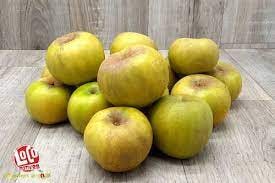Clochard apples.
I don’t know about you, but I’m an apple person. There are few varieties I won’t eat and even fewer I won’t cook. So it was with the sense of re-encountering an old friend that I noticed, this week, that a local farm store was selling clochards.
French slang, “clochard” means tramp. In the days when Les Halles, Paris’s biggest wholesale produce market, still dominated the centre of the city, the sounding of a bell or cloche signified that trading was over for the day. Hearing it, the homeless, hovering outside, surged in to scavenge discarded and over-ripe fruit and vegetables, stale bread, unsold meat.
One look at a Clochard apple and you could see why it earned that name. If ever an apple looked like a bum, this was it: lumpy, mis-shapen, muddy yellow/brown skin, spotted with the brown specks associated with blight or insect damage. If you saw such apples lying on the ground of an orchard, you wouldn’t bother picking them up.
I first saw them in an icy market hall on the Atlantic coast of France. Each day, the lady opened her little stall, a squared off U-shape just big enough to stand in, and to reach the contents of each basket or box without walking a step. Almost everything came from her garden and orchard; the eggs were from her hens, and any unsold fruit went into the jams she bottled herself.
In season, nobody stocked more succulent tomatoes. A supermarket buyer would have turned up his nose at their knobbiness, their folds, their little patches of unripened green, but they remain, particularly when dressed with oil, salt, lemon juice, and her pungent basil and garlic, the most delicious I’ve ever eaten.
“Madame,” I said, “An apple…for cooking….”
She didn’t hesitate. From under the counter, she brought out a box with a dozen or so fruit.
“Clochards,” she said.
I’d expected glossy green Granny Smiths, or maybe hard, small Reinettes, the French version of the Cox’s Orange Pippin I knew from living in East Anglia.
“And you recommend them,” I said dubiously.”For a compote, say?”
“Try them.” She filled a bag. “If you don’t agree, bring them back.”
That night, I pan-fried two pork chops in a little butter, peeled and sliced one of the apples, scattered the pieces over and around the pork, reduced the heat almost to nothing, and put on a lid.
When I lifted it twenty minutes later, a wave of steam carried the odours of fruit and meat into the kitchen. Cooked in their own juices, the chops were succulent and tender. The pieces of apple, far from turning to mush, were translucent and intact. Better still, heat at the bottom of the pan had caramelised their sugar, turning the lower surfaces a rich brown.
Lifting the chops onto a plate, I surrounded them with the apple pieces, deglazed the pan with a little Calvados,tossed in a pinch of salt, and poured the sauce over the dish.
It was the kind of simple cooking France has made its own: local ingredients, bought fresh, prepared quickly and simply. Why do we never learn?




Thanks, Lori. Much appreciated. I look forward to preparing this and other dishes for you next time you're in Paris.
This may be my favorite piece you’ve written so far! You perfectly captured a precious moment.